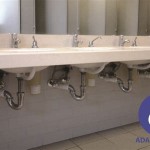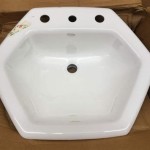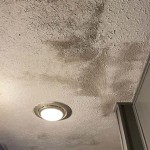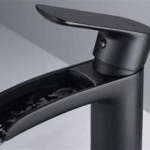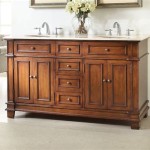Addressing the Odor Issue: Bathroom Sink Hole Accessories and Smell Prevention
The bathroom sink, a ubiquitous fixture in modern homes, is frequently a source of unwelcome odors. These smells, often emanating from the drain hole, can disrupt the cleanliness and freshness of the bathroom environment. While cleaning solutions and drain cleaners are commonly employed, addressing the root causes of these odors often requires a more nuanced approach. This approach involves understanding the potential sources of the smell and utilizing specialized bathroom sink hole accessories designed to mitigate or eliminate the problem.
The unpleasant smells originating from a bathroom sink drain typically stem from a combination of factors. Organic matter, such as hair, soap scum, and food particles (in bathroom sinks near kitchens), accumulates within the drainpipe and the P-trap. This accumulation provides a breeding ground for bacteria, which break down the organic matter, releasing foul-smelling gases like hydrogen sulfide, methane, and ammonia. Furthermore, the biofilm, a slimy layer of microorganisms clinging to the drainpipe walls, contributes significantly to the odor problem. The P-trap, designed to hold water and thereby prevent sewer gases from entering the bathroom, can sometimes fail to function effectively due to evaporation or improper installation. This allows sewer gases to escape into the bathroom, exacerbating the odor issue. Therefore, a multi-pronged strategy involving cleaning, maintenance, and the use of appropriate accessories is essential in eliminating these unwanted smells.
Understanding Common Causes of Bathroom Sink Odors
Before implementing any solutions, it is crucial to understand the specific contributors to the unpleasant smells. One of the most prevalent issues is the buildup of organic matter within the drain system. Hair, shed skin cells, soap residue, toothpaste, and other debris combine to create a matted, decaying mass that fuels bacterial growth. This bacterial activity results in the production of volatile organic compounds (VOCs), many of which have distinctly unpleasant odors. The biofilm that forms on the interior surfaces of the drainpipe further compounds the problem, acting as a persistent reservoir of odor-causing microorganisms. Inefficient water flow, often caused by partial blockages within the drain, can exacerbate the issue by allowing organic matter to stagnate and decompose more rapidly.
Another significant cause of bathroom sink odors is related to the P-trap, the U-shaped pipe located beneath the sink. This component is designed to maintain a water seal, preventing sewer gases from backflowing into the bathroom. If the P-trap dries out due to infrequent use or a leak, the water seal is compromised, and sewer gases can readily enter the bathroom. Furthermore, even if the P-trap contains water, its effectiveness can be reduced by siphoning, a phenomenon where the water is drawn out of the trap due to changes in pressure within the drain system. Finally, issues related to the venting system, which allows air to enter the drain system and prevent a vacuum from forming, can also contribute to odors. If the vent is blocked or improperly installed, it can disrupt the proper flow of air and water, leading to the release of sewer gases through the sink drain.
Material degradation of the drainpipe and its seals can contribute to odor problems over time. Plastic drainpipes can become brittle and develop cracks, allowing odors to escape. Rubber seals and gaskets can deteriorate and shrink, creating gaps that permit sewer gases to seep into the bathroom. Corrosion of metal drain components can also generate metallic odors and contribute to the overall unpleasant smell. Regular inspection and timely replacement of worn or damaged drain components are essential for maintaining a hygienic and odor-free bathroom environment.
Exploring Bathroom Sink Hole Accessories for Odor Control
A variety of bathroom sink hole accessories are designed to address the odor problem at its source. These accessories range from simple drain screens and stoppers to more sophisticated odor-trapping devices. Selecting the appropriate accessory depends on the specific cause of the odor and the desired level of odor control.
Drain screens and strainers are among the simplest and most cost-effective accessories. These devices are placed over the drain opening to prevent hair, soap scum, and other debris from entering the drainpipe. By reducing the amount of organic matter entering the drain, drain screens help minimize bacterial growth and subsequent odor production. They are available in various materials, including stainless steel, plastic, and silicone, and can be easily cleaned or replaced as needed. While drain screens are effective at preventing large debris from entering the drain, they may not be sufficient to address odors caused by biofilm or sewer gas leakage.
Specialized drain stoppers are designed to provide a tighter seal than standard stoppers. These stoppers often incorporate rubber or silicone gaskets that create a more effective barrier against sewer gases. Some stoppers also include a built-in odor-absorbing filter, which helps to neutralize any odors that may escape from the drain. These stoppers are particularly useful in bathrooms that are used infrequently, as they help to prevent the P-trap from drying out and allowing sewer gases to enter the room. However, it is important to note that even the tightest stopper may not completely eliminate odors if the source of the smell is located within the drainpipe itself.
Odor-trapping drain inserts offer a more advanced solution for odor control. These inserts typically contain a filter or absorbent material that captures and neutralizes odor-causing molecules. Some inserts also incorporate a one-way valve that prevents sewer gases from flowing back up through the drain. These devices are installed directly into the drainpipe and can provide long-lasting odor control. However, they may require periodic replacement as the filter or absorbent material becomes saturated. The effectiveness of odor-trapping drain inserts depends on the type of odor and the capacity of the filter or absorbent material.
Implementing a Comprehensive Odor Prevention Strategy
Addressing bathroom sink odors effectively requires a comprehensive strategy that combines regular cleaning and maintenance with the use of appropriate accessories. Simply masking the odors with air fresheners is not a sustainable solution, as it only addresses the symptom and not the underlying cause.
Regular cleaning of the sink and drain is essential for preventing the buildup of organic matter and biofilm. This includes removing any visible debris from the sink basin and using a drain cleaner or natural cleaning solution to flush out the drainpipe. Boiling water can also be poured down the drain to help dissolve grease and other buildup. Baking soda and vinegar can be used as a natural and effective drain cleaner. A mixture of baking soda and vinegar will create a fizzing action that helps to dislodge debris and neutralize odors. The frequency of cleaning depends on the usage of the sink and the tendency for odors to develop. A weekly or bi-weekly cleaning schedule is generally recommended.
Maintaining the P-trap is crucial for preventing sewer gas leakage. Regularly flushing the sink with water helps to ensure that the P-trap remains full and that the water seal is intact. If the sink is not used frequently, it may be necessary to manually add water to the P-trap to prevent it from drying out. Inspecting the P-trap for leaks and cracks is also important. Any damaged components should be replaced promptly to prevent sewer gases from escaping. Consider using mineral oil poured into the sink when you know you won't use the sink for an extended period to prevent water evaporation from the P-Trap.
Proper ventilation is essential for preventing the buildup of odors in the bathroom. Ensure that the bathroom has adequate ventilation, either through a window or an exhaust fan. Running the exhaust fan during and after showering or bathing helps to remove moisture and prevent the growth of mold and mildew, which can also contribute to odors. Check the venting system to ensure that it is not blocked or improperly installed. A blocked vent can disrupt the proper flow of air and water in the drain system, leading to the release of sewer gases. If you suspect a problem with the venting system, consult with a qualified plumber.
By understanding the common causes of bathroom sink odors and implementing a comprehensive strategy that includes cleaning, maintenance, and the use of appropriate accessories, it is possible to create a fresh and odor-free bathroom environment.

Kitchen Sink Downspout Flexible Stretchable Anti Odor Filter Pipe Bathroom Clogging Accessories Sewer Set Universal Inline Side Drain Save Space Temu United Arab Emirates

Anti Odor Drain Plug Clogging Insect Cap Bathroom Kitchen Filter Floor Core Sink Accessories Lazada

304 Stainless Steel Sewer Face Basin Washbasin Water Remover Table Hand Wash Pool Anti Odor Drain Accessories Temu

Universal Pop Up Sink Drainage Filter Basin Bathtub Stopper Anti Odor And Insect Proof Quick Bathroom Accessories Lazada

Universal Bathroom Sink Stopper Anti Odor Wash Basin Core Pop Up Plug Press Type Drain Washbasin Filter Bathtub Hair Catcher Accessories Temu Es

Universal Washbasin Water Head Leaking Stopper Bathroom Sink Drain Strainer For And Bathtub Replacement Parts Silver Com

Okdeals Stainless Steel Prevent Backflow Squatting Pan Accessories Bathroom Fitting Toilet Odor Stopper Anti Blocking Cover Deodorant Smell Plug Lazada

Fix For Smelly Sink So Ready A New House Bathroom Drain Cleaning Drains

Universal Bathroom Sink Stopper Basin Pop Up Drain Filter Stainless Steel Push Type Bounce Core Converter Strainer Plug For 0 98 Hole Accessories Temu

How To Clear A Clogged Drain Reviews By Wirecutter
Related Posts

